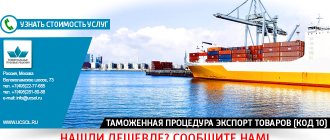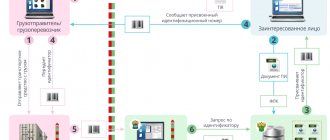What is a goods declaration
Keep records of exports and imports using the simplified tax system in the Kontur.Accounting web service.
Currency accounting and work instructions, taxes, automatic salary calculation and reporting in one service Get free access for 14 days
A declaration of goods (DT) is a document containing all the information about a foreign economic transaction and the goods transported. This is an application for the use of imported goods under various customs regimes - processing in the customs territory, re-import, release for free circulation.
Basic forms and types of customs declaration
Russian legislation provides for two forms of declaration of transported goods:
- oral form - a statement to customs representatives about the absence of goods that are subject to mandatory written declaration in the cargo being moved across the border. It is used exclusively by individuals when moving goods for non-commercial (personal) purposes (luggage, hand luggage, etc.). The oral form of customs declaration also includes the declaration of goods using a system of two corridors (“red” and “green”). A person who does not have goods that are required to be declared can pass through the “green” corridor. This makes it possible to facilitate the work of customs and simplify the procedure for crossing goods at the border;
- electronic form – all necessary data regarding customs declaration, including declaration, goods transport and other documents are provided in electronic form;
- written form – a statement from an individual to representatives of the customs authority about the availability of products that are required to be declared.
On the territory of the Russian Federation, written and electronic forms of declaration are most widespread.
The use of a written declaration form makes it possible to submit an application in any form, as a customs declaration in the established forms, as well as a transport document.
Declaration of products for personal use, with the exception of those placed under the customs transit procedure and sent via international mail.
Documents provided in electronic form are certified and confirmed by an electronic digital signature. Electronic declarations are checked using a special customs information system within three working hours from the moment of its acceptance. Electronic customs declaration cannot be used when private individuals travel abroad.
There are also several main types of customs declaration:
- By way of performing the procedure:
- incomplete declaration – an incomplete declaration can be submitted for imported or domestic export products. Incomplete declaration is used in cases where it is impossible to provide the data necessary for registration for reasons beyond the control of the declarant. In such a case, a certain period is given (for imported goods - 45 days, and for exported goods - 8 months) for providing the missing data from the moment the incomplete declaration is accepted;
- full declaration - filled out for all imported and exported products, especially for legal entities and commercial activities;
- temporary declaration - this type of declaration is applicable only to Russian products imported for export. This form implies a lack of information necessary for the calculation and payment of customs duties;
- preliminary declaration - used for foreign products that have not yet arrived in the customs territory or have not completed internal customs transit.
- By type of customs declaration and the nature of its completion:
- declaration for cargo or goods - submitted in cases of movement of products by participants in foreign economic activity (economic entities);
- transit declaration – used when placing cargo under the appropriate customs transit regime. Commercial, transport and other documents can be provided as this type of declaration;
- passenger customs declaration – used when moving goods by individuals for subsequent personal use. This declaration is drawn up by a person who has reached the age of 16;
- transport declaration – is issued when moving various types of vehicles related to international transport across the customs border. As such a declaration, the carrier’s standard documents, which are provided for in international transport agreements, can be presented.
The procedure and form for filling out all types of declarations are approved by the relevant Decisions of the CCC.
What is indicated in the import customs declaration
The import declaration is filled out by a representative of the sender or the owner of the cargo. Please provide the following information:
- about the shipper;
- about the recipient of the goods;
- about the state of the foreign economic partner;
- about the country of origin of the goods;
- about the EAEU HS code;
- about the characteristics of the product;
- about the terms of delivery;
- about the currency of the transaction;
- about the method of cargo delivery (road, railway, air, sea transport);
- about the customs office where customs clearance will take place;
- on the presence of restrictions on the import of goods, if any (quota);
- about customs value, customs duties and fees;
- about documents confirming information about the product.
You can familiarize yourself with the form of the declaration of goods and the rules for filling it out in the Decision of the Commission of the Customs Union of the EAEU dated May 20, 2010 No. 257.
For goods to be released from customs, a correctly completed goods declaration is not enough. Be sure to pay all taxes and customs duties.
Rules for filling out the passenger customs declaration.
The customs declaration is a multi-page document consisting of two parts: a main form and an additional form. Both parts are filled out by individuals aged 16 years and older if they have money or property that must be declared. The first form is aimed at filling out information about goods subject to declaration, as well as, if desired, about funds not exceeding 10 thousand USD. In turn, the second one is filled when cash is transported in excess of the limit.
Main form.
Filling out the customs declaration begins with the main form, where you must indicate the entry or exit, as well as:
1. Personal data of the passenger:
- FULL NAME;
- The country in which the person resides;
- Citizenship;
- Series and number of the international passport;
- Country of destination and departure;
- Do children follow the citizen and, if so, their number.
2. Information about the method of transporting property:
- Accompanied – goods directly transported by a person;
- Unaccompanied – if the goods do not travel with a person and do not cross the border at the same time;
- Delivered by carrier – if the goods are delivered by a transport company.
- As well as the number of places in each method.
3. Data on the transported property:
- If desired, indicate if there is currency in the amount of up to 10 thousand dollars, what kind and how much;
- Indicate whether money over 10 thousand dollars is transported;
- Provide information about vehicles, if transported;
- Mark the presence or absence of prohibited items, as well as restricted items.
4. Detailed information about the goods transported in tabular form, indicating the name, quantity, weight, as well as the estimated cost (this item can be filled in at will).
5. Date of completion and signature of the declarant.
Additional form.
Filling out the customs declaration application is carried out when a person transports securities, bills, checks, cash and other monetary instruments. In turn, the form provides the following information:
0. Declaration type (entry or exit);
1. Passenger information:
- FULL NAME;
- Date and place of his birth;
- Country of residence, as well as citizenship;
- Type, number, series of identification document;
- Residence and registration address in Russia;
- Visa number and date of issue;
2. Information about transported money and securities:
- Type of currency;
- The amount of each type of currency;
- Information about securities;
3. Who is the owner of the transported funds: the declarant himself or another person. If the owner is different, then you must fill in his full name (name) and residential address (location).
4. Data on the origin of funds and instruments;
5. The intended purpose of using the money;
6. Information about the route:
- Country of departure, as well as arrival, indicating dates and transit countries;
- Type of vehicle used for travel;
- Date of completion and signature.
Download the passenger customs declaration form.
Declaration of Conformity
Keep records of exports and imports using the simplified tax system in the Kontur.Accounting web service. Currency accounting and work instructions, taxes, automatic salary calculation and reporting in one service Get free access for 14 days
Domestic legislation is replete with the word “declaration”. And sometimes they refer to completely different documents. For example, in addition to the declaration of goods, there is also a declaration of conformity, which in certain cases is required to be completed upon import.
Important! Distinguish between the concepts of certification and declaration of conformity. Certification is carried out by an independent expert in the name of both the Russian recipient of the cargo and the foreign company. The declaration of conformity is drawn up by the recipient himself, and the certification body only registers it. However, the declaration can only be registered for a Russian person.
For which products should a declaration of conformity be issued?
Declaration of conformity is a document confirming that the product meets the requirements approved by technical regulations. It is issued only for certain groups of goods that you will not import beyond customs without a declaration of conformity. In order not to rummage through the technical regulations of the Customs Union and GOSTs, we recommend determining the code of the Commodity Nomenclature of Foreign Economic Activity of the EAEU. Using this code, you will quickly find information about the need for certification or declaration.
You can familiarize yourself with the product nomenclature and the algorithm for determining it in our article on the EAEU Commodity Nomenclature for Foreign Economic Activity.
If it is difficult to decide on the code, then here is a list of documents establishing mandatory certification and declaration of goods:
- Decree of the Government of the Russian Federation dated December 1, 2009 No. 982;
- Technical regulations of the Customs Union, including on food safety, on the safety of milk and dairy products, on the safety of light industry products, and so on.
Features of traveling with minors.
If minor children are traveling with the passenger, then when filling out the customs declaration this fact is indicated, and their number is also indicated. However, you must have the following documents with you:
Birth certificate for children under 14 years of age.
And this must be the original document, and not a photocopy of it. Border Patrol agents generally will not accept even certified copies, especially if the minor is traveling unaccompanied by an adult. This is due to the fact that the evidence does not contain a photograph of the child. In turn, this makes it difficult to identify a person and allows a copy to carry other children, or even several.
Read: Rules for the import and export of currency from Russia by individuals.
If the child’s parents are not married, then when crossing the border with one of the parents, you will need to provide the notarized consent of the other for the child to leave the country.
Foreign passports for children over 14 years of age.
If obtaining a Russian passport is mandatory for all citizens of the Russian Federation from the age of 14, then a foreign equivalent can be issued at any age. It is not necessary in everyday life, but only until the teenager leaves the territory of Russia. If you plan to travel abroad after a person reaches 14 years of age, it is important to obtain a passport in a timely manner. Without it, travel will be denied, since a birth certificate for persons of this age is not the main document confirming identity.
What data should the declaration of conformity contain?
Keep records of exports and imports using the simplified tax system in the Kontur.Accounting web service. Currency accounting and work instructions, taxes, automatic salary calculation and reporting in one service Get free access for 14 days
The list of information that must be disclosed in the declaration is presented in paragraph 4 of Order of the Ministry of Economic Development of the Russian Federation dated November 24, 2014 No. 752. Required information includes:
- information about the person submitting the declaration;
- name of the manufacturer of the goods;
- information about the object of declaration, allowing to identify this object;
- information about the documents whose compliance you confirm;
- information about documents or examinations performed, proving that the object meets the technical requirements;
- validity period of the declaration of conformity;
- EAEU HS code;
- information about attachments to the declaration.
A declaration of conformity that complies with all requirements is sent to the Federal Accreditation Service.
Registration of transit declaration
After completing the transit declaration, the registration procedure follows. Let's take a closer look at it.
Package of documents
To begin registration, the declaration must be submitted to the customs authority. The following documents are attached to it:
- A document that confirms the applicant’s right to carry out the registration procedure.
- A document confirming the conclusion of a purchase and sale transaction.
- Bank receipt for payment of customs duties. Methods for paying customs duties are here.
- Transport and commercial papers, etc.
Who does the registration?
The registration of the document is carried out by an authorized customs officer. To begin the procedure, you must submit the appropriate package of documents.
After receipt of all papers, registration is carried out within 2 hours. The employee assigns an individual number to the paper.
Failure Cases
There are also frequent cases of refusal by the customs authority to carry out registration. Under what conditions is this possible? Refusal is possible in the following cases:
- The paper was submitted to a government agency that does not have sufficient powers to carry out the procedure.
- The document was provided by a person who did not have the authority to do so.
- The information specified in the declaration is not sufficient to register the delivery.
- No signature.
- Non-compliance with the form established by law.
- Presence of typos and errors.
The transit declaration is filled out strictly in accordance with the invoice.
Declaration of indirect taxes on import
Keep records of exports and imports using the simplified tax system in the Kontur.Accounting web service. Currency accounting and work instructions, taxes, automatic salary calculation and reporting in one service Get free access for 14 days
VAT and excise taxes are paid by importers of goods from EAEU member countries. Value added tax is paid by all special regime holders and those who are exempt from VAT.
Submit your import tax return by the 20th day of the month following the reporting month. The reporting month is the month when you received the imported goods, or the month in which you need to make a lease payment.







